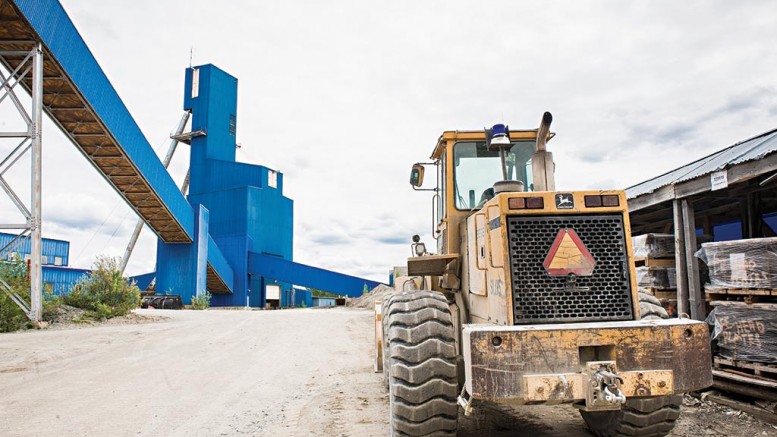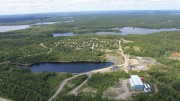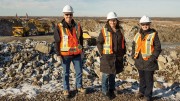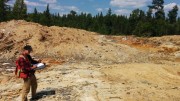Anthony Makuch took the helm of Kirkland Lake Gold (TSX: KGI) on July 18, 2016. Before joining the Ontario-focused gold producer, Makuch was president and CEO of Lake Shore Gold, where he worked from 2008 until its acquisition by Tahoe Resources on April 1, 2016. Previous posts include FNX Mining, Dynatec and Kinross Gold. At Kinross, Makuch worked at the Macassa mine, which is now owned by Kirkland Lake Gold. In this interview, Makuch shares his outlook for the company:
The Northern Miner: What were your greatest accomplishments at Lake Shore Gold?
Anthony Makuch: It was a junior exploration company in the Abitibi greenstone belt when I joined and we had a deposit — now known as the Bell Creek mine — in Timmins. We took it from a company with a $12-million budget and developed it into a mining company producing 180,000 oz. gold a year, with revenues of nearly $300 million. It grew from a small company with a few employees to one employing over 800 people, including contractors, and contributing to the economy of northeastern Ontario.
When Lake Shore asked me to join them in 2007, people were sceptical, and said most of the gold had already been found or mined out. We proved that not only was there a lot more gold to find, but that we could develop it and profitably mine it. And then the company merged with Tahoe Resources in April 2016, which helped Lake Shore shareholders become a part of a much larger company. We grew it from a small junior explorer to a producing company, and it is still a strong asset, with a lot of growth potential. That’s the achievement: being able to build something and create value for shareholders, communities and people.
TNM: What is your vision for Kirkland Lake Gold? It is already a producing company with four mines in Ontario — Macassa in the Kirkland Lake camp and the Holt, Holloway and Taylor mines along the Porcupine-Destor fault zone — as well as two mills. What do you hope to accomplish in your new role?
AM: A lot of the hard work in the past has been done by previous management groups. Imagine that you have to run a marathon and someone has already run the first 20 miles. You just have to continue on the path. When the Kirkland Lake team restarted mining in the mid-2000s, they bought the Macassa mine and the other four historical assets for $5 million. Today the company is worth $1.4 billion. These are the kinds of things we can achieve in the industry. The company acquired St Andrew Goldfields at the end of January 2016, and now has four operating mines and two centrally located milling facilities. What we want to do now is show long-term sustainable and profitable production, that’s the number-one goal, to keep costs down and get them even lower, and also invest in exploration and infrastructure.

Workers at Kirkland Lake Gold’s Macassa project. Credit: Kirkland Lake Gold.
TNM: How much mine life do you have remaining at your assets?
AM: Right now, the Holt mine has a five-year mine life and Holloway has maybe a year-and-a-half of mine life remaining. Taylor is a new mine, with a mine life of three to five years based on current reserves. The goal is to demonstrate long-term, sustainable, responsible and profitable production. We have to invest in exploration and development at these assets, as there is a lot of gold to find.
At Macassa, the current reserves support a mine life of over five years. We’ve got to continue to convert resources into reserves and grow the resources to show a longer mine life at Macassa, and ideally we’d like to see between five to 10 years of mine life at all of our operations.
We also need good processes and to build mines that operate as low-cost as possible. We may be in a good gold-price environment today, but I’ve seen cycles, and we should never be complacent when we have high gold prices, because prices can go down. If we can keep cash costs below US$650 per oz., we have an opportunity to be here for a long time.
TNM: Can you talk a little about your exploration plans in Ontario?
AM: We recently raised $15 million as part of a flow-through financing and our goal is to beef up our exploration spending, as we have a lot of ground to explore.
We have prospective targets within the Kirkland Lake Camp, and this area is the priority for exploration. At Macassa, the South Mine Complex (SMC) was discovered in 2003, so it is fairly new. We’re going to test the easterly extension of the SMC and look for similar mineralization across a 3 km strike length, as well as test the older parts of the camp at depth. The possibilities of revitalizing the Kirkland Lake Camp are tremendous.
Similarly, around Holt and Holloway, which sit 80 km north of Kirkland Lake along the Porcupine-Destor fault zone (PDFZ), there is exploration upside there, and it’s been under-explored.
If you don’t spend the money to drill the holes, you’re not going to find anything. You can spend money just sitting in an office, but you have to spend money doing physical work, and we have a lot of exploration to do.
If we get a sense of the geology and mineralization there are many discoveries to come out of that region — the area that we have both in Kirkland Lake as well as along the PDFZ at Holt, Holloway and Taylor. All of our assets are pretty close — about within an 80 km radius.
We boosted our exploration up to $24 million for 2016, and added $6 million in flow-through funds. Some of the $15 million from the financing is going to carry over into exploration next year. Starting in 2017 and 2018, we expect to spend no less than $25 million each year on exploration.
TNM: How will the exploration funds be spent for the rest of this year?
AM: Most of it will be used on surface drilling and looking for deposits — not necessarily looking at extensions of old deposits, but extensions of previous discoveries that hadn’t been mined.
At Kirkland Lake, the Macassa mine is on the far west part of the property, including discoveries like the SMC.
Historically, most of the ounces in Kirkland Lake came from the central part of our property along the Main Break system, namely at the Wright-Hargreaves, Lake Shore and Teck Hughes mines — well over 50% of the ounces mined in Kirkland Lake came from these three deposits.
We want to start near the SMC — the far western portion of the camp — and we want to move eastward to explore along the same horizon. Nobody has explored for SMC-style mineralization along these three deposits, and that’s where most of the ounces were in the camp, so we want to explore back to the east.
We’re also going to explore the Main Break mineralization at depth. These historical mines have been shut down, but there’s no reason to say the mineralization stopped at depth. There’s a lot of exciting exploration to be done within the Kirkland Lake Camp.
TNM: Can you elaborate on the SMC?
AM: It’s a fairly new discovery, the grades are very good, with an average reserve grade of just over 19 grams. You are in a camp that has had well over 75 years of mining, and we’ve found new mineralization, so it’s exciting. The grades are exceptional, and we are averaging over 15 grams per tonne, and the grade gets better at depth. So we can chase it to depth and to the southeast.
TNM: In May you released nice-looking intercepts from underground exploration drilling on the SMC.
AM: At the SMC, underground drilling focused on the south claims, 800 metres south of the No. 2 shaft at the Macassa mine complex. Some of the intercepts were 76.5 grams gold over 3.1 metres and 174.2 grams gold over 6 metres.
The potential to find more of that mineralization as we step out to the east beyond the border of the Macassa mine itself is exciting … there is a lot of potential to find mineralization near some of the highest-grade underground deposits in the world.
TNM: What about the exploration potential at the Holt-Holloway and Taylor mines?
AM: Holt-Holloway has exploration upside. There are many discoveries from this area. We’re exploring along the PDFZ in areas that haven’t seen the exploration that Timmins or Kirkland Lake has had over the last 20 to 30 years, so that’s an exciting prospective area, as well.
The Porcupine camp has seen over 5 million metres of drilling. I doubt the property we have along the PDFZ has had more than half a million metres of drilling. The thing about this trend — the PDFZ — is that we’re in some of the oldest rocks in the world. These rocks could host mineralization very deep.
If you look at Agnico Eagle’s LaRonde mine in Quebec, it’s down well below 3,000 metres, and at Macassa, we’re down to 5,400 feet at the SMC, and we have found mineralization down to below 6,000 feet. We’re sitting at 1,300 metres below surface, and we intend to get down to 2,000 metres at Macassa.
TNM: Kirkland Lake Gold recently delivered another quarter of positive earnings, free cash flow and a strengthened balance sheet. At the end of the first half the company had cash and equivalents of $170 million. In terms of free cash flow you generated $57.3 million in the first half of the year, while corporate debt at the end of June stood at $119 million. As for production, the company produced 130,613 oz. gold at operating costs of US$641 per oz. gold sold and at AISCs of US$925 per oz. gold sold. Are you happy with these numbers?
AM: The company is generating free cash and we are well funded to continue our work. Our convertible debentures total $119 million. One is due in June 2017 and a second at the end of December 2017. We are putting ourselves in a strong position to pay both of them back.
We also have an opportunity to buy back 1% of our royalty with Franco-Nevada on our Kirkland Lake properties for US$30 million — before the end of October. We’re looking seriously at doing this, as well as buy back our other debt when it comes due.
TNM: What about production?
AM: We produced over 130,000 oz. in the first half and we have full-year guidance of 270,000 to 290,000 oz., so we think the second half of the year is going to be better than the first half.
We’re looking to do 10,000 more oz. gold in the second half than in the first half of the year. We expect to have a solid second half of the year and we could beat our cash cost guidance.
TNM: Are AISCs a little high? Your guidance for this year is US$1,000-US$1,050 per oz. gold produced.
AM: It’s not high if you look at the industry as a whole. Our AISCs are lower than the industry’s average, and it is a fairly fully loaded cost, with all capital included. We’re competitive in cost structure. We’d like to get it down more.
At US$1,050 per oz. it shows that in this gold market environment we still need to maintain prudency. Our goal is to create sustainable, long-term profitability.
TNM: Are you contemplating any acquisitions, or do you have enough ground to keep you busy for a while?
AM: We are fairly well set up in terms of our land position. We’re well situated along the ’04/Main Break in the Kirkland Lake Camp and similarly well situated along the PDFZ, so we have fairly good land. Definitely there are pieces in between that we don’t own, and we’re always interested in growing our land position.
We have two mills in the area, and if we can keep the mills full feeding from a number of sources, it’s going to be beneficial. We’re happy with our land position, but we’re always open to looking for other pieces of ground around us. There’s opportunity for growth at Macassa, and Taylor is really coming on. There is potential to grow production from organic internal growth.
And on exploration, we have the opportunity to look at other deposits and look at ways to bring in discoveries and development.
TNM: Perhaps we should close with Macassa, where you started working in 1992 as head of technical services when the mine was owned by Kinross Gold. What are your goals for Macassa?
AM: Production there is close to 160,000 oz. a year. We have a good, experienced and well-motivated workforce. My goal is to demonstrate long-term sustainable production at these levels. That’s pretty exciting and ties in with the exploration. Macassa will be our launching point for the rest of the camp as well.
I can see Machos over the next five years re-establishing some of the old shafts for more ventilation, and maybe a new shaft into the heart of the mineralization to support the SMC to the east and along the east end of the property. This would be important for the company.
We have a lot of growth and value to provide as we continue our work … and a lot of good people on the ground to get this done.






Be the first to comment on "Interview: Kirkland Lake Gold’s new CEO discusses vision for the company"